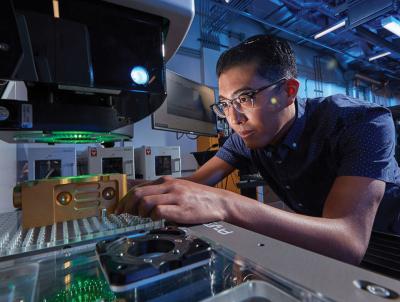Ensuring a modernized safe, secure, and effective nuclear weapons stockpile
LLNL’s foremost responsibility is to ensure the performance of the nation’s nuclear arsenal without nuclear testing. Knowledge gained through experiments, theory, and simulations is applied to assess the condition of current weapons and pursue programs that modernize the stockpile and weapons production processes.
Annual Stockpile Assessment
In FY 2022, LLNL completed Cycle 27 of the annual stockpile assessment. The process included a formal comprehensive peer review between LLNL and Los Alamos National Laboratory of each other’s weapons systems. Laboratory scientists performed experiments and enhanced physics and engineering simulation codes to improve predictability and strengthen the technical foundation that supports assessments and certification of weapons. LLNL also completed needed surveillance, testing, and analysis activities to assess the condition of and sustain the B83, W80-1, and W87-0 stockpile systems.
Stockpile Modernization Programs
LLNL is partnered with Sandia National Laboratories (SNL) as the design agencies to develop and certify the W80-4 warhead for the bomber-delivered Long-Range Standoff (LRSO) missile. The Laboratory is making excellent progress in Phase 6.3 (development engineering) of the W80-4 Life-Extension Program (LEP) and preparing for entry into Phase 6.4 (production engineering). Programmatic activities include executing baseline design reviews, completing multiple high-fidelity engineering tests, activities to improve product producibility, and supporting U.S. Air Force LRSO flight-test activities. The plans to refurbish or replace aging components and materials in the W80-4 include using new manufacturing methods that minimize costs, increase throughput, and reduce the need for environmentally sensitive materials and processes.
LLNL and SNL are also NNSA’s design agencies for a warhead to replace the aging W78. In October 2021, the W87-1 Modification Program moved to Phase 6.2A, during which the Weapon Design and Cost Report (WDCR) is developed. Slated for deployment on the U.S. Air Force’s Sentinel ballistic missile (under development) in 2030, the W87-1 will be the first modern warhead that is 100 percent newly manufactured. LLNL successfully completed its portion of the WDCR, yet total program cost issues need to be addressed to support transition to Phase 6.3. Technical activities are focused on maturing weapon design options and modern manufacturing methods.
Enclaves and Production Partnerships
The W80-4 and W87-1 programs require the full array of NNSA’s computational, experimental, and manufacturing capabilities, which must be upgraded and better integrated to meet stringent production deadlines. LLNL is pioneering the use of enclaves to accelerate design-to-deployment within NNSA’s Nuclear Security Enterprise (NSE). Researchers from the Laboratory and the Kansas City National Security Campus (KCNSC) work side by side at the Polymer Enclave at LLNL using machines, tools, and other production equipment that are equivalent to resources at KCNSC. They are producing development parts needed for the modernization programs and are co-developing with other stakeholders technological advances in additive manufacturing.
The Laboratory is also establishing an Energetic Materials Development Enclave at Site 300 in partnership with the Pantex Plant. This enclave will drive a novel approach to accelerate the adoption of new explosive materials and production capabilities within the NSE. In addition, Livermore and the Y-12 National Security Complex have teamed up to rapidly modernize technology and production methods for crucial weapons components. Utilizing manufacturing space in Oak Ridge, Tennessee, the joint LLNL and Y-12 materials team successfully installed and tested an electron beam cold hearth melter—a machine that can melt and cast various metals including uranium alloys. The team has produced test metal ingots with recycled materials and demonstrated in situ alloying capabilities.
Preparing for Exascale
LLNL is fully engaged in preparing for the 2023 arrival of El Capitan, with a peak performance expected to exceed 2 exaflops (quintillion calculations per second). The machine is a major advance in supercomputer size and architecture and will be used by NNSA scientists to run complex, high-fidelity multiphysics simulations that address high-priority issues such as stockpile modernization. Its capabilities will greatly surpass those of 125-petaflop Sierra, NNSA’s flagship supercomputer, which is also located at LLNL. Completed in early FY 2022, the $100-million Exascale Computing Facility Modernization project provides the necessary power and cooling for El Capitan (see Managing for the Future). Teams of code developers are using three early-access systems—rzVernal, Tioga, and Tenaya—as a “testbed” for assessing and improving the performance of applications. While small compared to El Capitan, these early-access systems rank among the top 200 supercomputers in the world. They include some components that will be used in El Capitan and provide an early test of the larger machine’s architectural features.
Stockpile Stewardship Experiments
Experiments in support of stockpile stewardship ranged from tests to study the chemistry of high-explosive detonations at HEAF to high-energy-density physics tests at NIF (see National Ignition Facility). In August 2022, LLNL and SNL researchers successfully conducted a high-priority abnormal thermal environment test for the W80-4 LEP at Site 300’s Contained Firing Facility. The experiment thermally exposed the test device through a series of safety-relevant events with data captured by an extensive suite of diagnostics. The collaborative Miramar experiment was also performed at Site 300. Miramar was a milestone final preparatory test for the Nimble series of subcritical nuclear tests that will be conducted underground at the Nevada National Security Site. Nimble experiments will play a key role in assessing the safety, security, and effectiveness of the U.S. nuclear stockpile and will provide data that is crucial to certifying that the modernized weapons will perform as expected.







